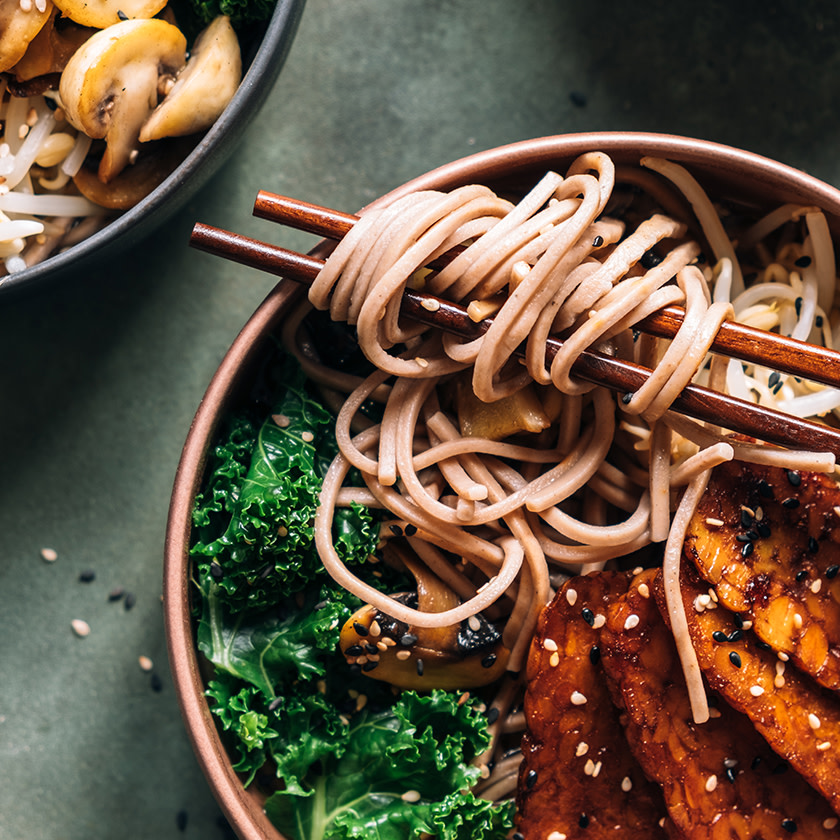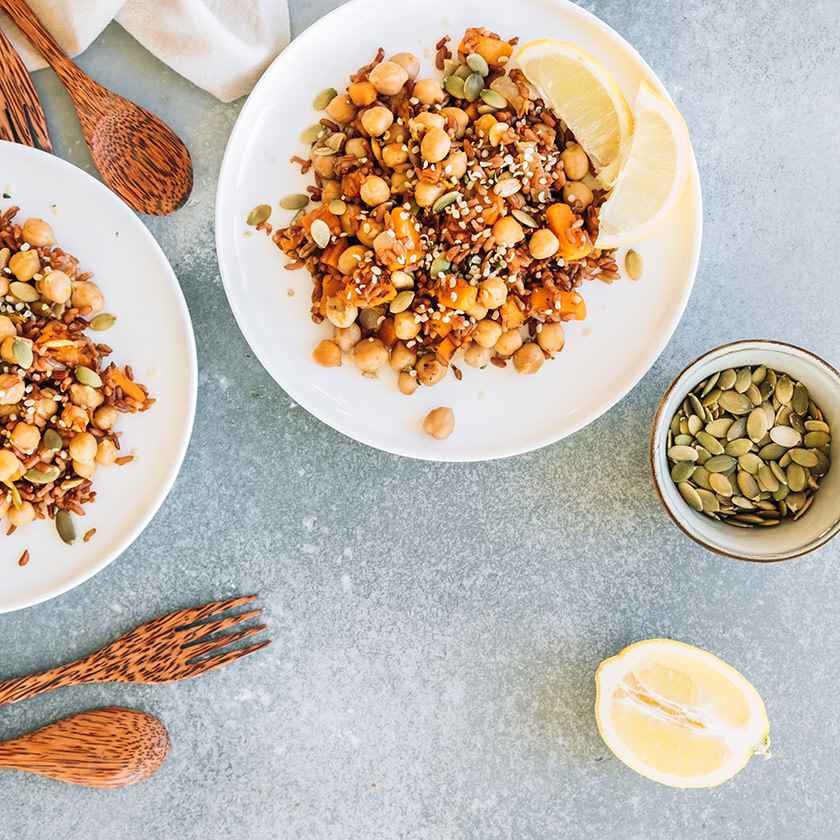One of the most persistent myths about protein? That more is more, especially if you live a fairly active lifestyle. In reality, nutrition experts will argue that it’s actually often about quality over quantity—and that’s true no matter how often you work out. In other words, instead of focusing on how many grams of protein you consume, to truly optimize muscle protein synthesis, you might want to consider the source instead. And that’s where the idea of complete protein comes in.
Of the 20 amino acids, the 9 “essential” amino acids are:
• Histidine
• Isoleucine
• Lysine
• Methionine
• Phenylalanine
• Threonine
• Tryptophan
• Valine
Basically, a food is considered “complete” if it contains these 9 essential amino acids in adequate amounts. This distinction is important, because while several plant-based foods technically contain all nine essential amino acids, they might not contain them at the appropriate levels, or in their most digestible forms—which means that they might be high-quality sources of protein, but we can’t actually classify them as “complete.” (2)
“Eating complete protein sources can help ensure our bodies have the ability to build new proteins necessary for normal functioning,” adds dietitian Dr. Lisa Young, Ph.D., RDN, author, and adjunct professor of nutrition at New York University. The good news for vegans and vegetarians? They can still get enough protein in their diet by mixing various plant-based proteins. It’s all a matter of knowing which ones to combine. (Spoiler: We did some of that legwork for you.)
Below, find seven complete plant-based proteins (and food combinations) to add to your regular meal rotation.
Both Shapiro and Dr. Young also recommend buckwheat or soba noodles, which are made of buckwheat, as a protein food worthy of a spot in your meal rotation. Dr. Young notes that buckwheat is high in fiber, which is good for digestion and has a low glycemic index. While buckwheat does contain all the essential amino acids, you may want to add shelled edamame to your soba noodle salad to help make it a “complete” meal. (4)
Still, quinoa’s nutritional resume on its own is nothing to scoff at. “Quinoa delivers 8 grams of protein per serving along with iron, magnesium, and fiber,” says Amy Shapiro, MS, RD, CDN, founder of Real Nutrition. (3)
Both Shapiro and Dr. Young also recommend buckwheat or soba noodles, which are made of buckwheat, as a protein food worthy of a spot in your meal rotation. Dr. Young notes that buckwheat is high in fiber, which is good for digestion and has a low glycemic index. While buckwheat does contain all the essential amino acids, you may want to add shelled edamame to your soba noodle salad to help make it a “complete” meal. (4)
For omnivores and vegetarians, eggs are another great complete protein food to have on hand as each egg contains all the essential amino acids in sufficient quantities. “[Eggs are a] great source of protein and also include omega-3 fatty acids,” Shapiro says. The best part is that eggs are typically inexpensive and endlessly versatile. (5,6)
4. Hemp seeds (+ chia + oats + milk)
These tiny powerhouses contain all the essential amino acids—not to mention that they also contain omega-3 fatty acids and fiber. But they’re still not entirely a complete protein, which is why a souped up overnight oats recipe might be in order: Combine hemp seeds, chia, oats, and other nuts and seeds with the milk of your choice for a breakfast that’s more protein-diverse. (7)
Greek yogurt is a vegetarian-friendly complete protein food that contains all the essential amino acids in sufficient quantities—not to mention that each serving boasts almost 10 grams of protein. “Add in some nuts, seeds, grains, and fruit, and you have a well-balanced meal that provides calcium, protein, and satisfaction,” Shapiro says. If you want to get creative, you can incorporate Greek yogurt into various recipes, including baked goodies, marinades, sauces, dressings, and dips. (8)
Soy also tops the list of RD-recommended complete protein foods, and with good reason. “Soybeans contain molybdenum, an essential trace mineral, vitamin K, as well as manganese and folate,” Dr. Young says. “Soybeans also contain both soluble and insoluble fiber and omega-3 fatty acids.” And this goes for all of soy’s various forms. So consider this your permission slip to stock your grocery cart with edamame, tofu, and tempeh. Tempeh is fermented, which can support gut health, says Dr. Young, and it also contains calcium. (9, 10, 11)
Again, while they’re technically incomplete proteins, legumes—including peas, the protein-packed star of Essential Protein—contain all nine essential amino acids and tend to be high in lysine. But they do run a little short on the amino acid methionine, which is where a grain source can come in handy. As fate would have it, rice is high in methionine (and short on lysine). As for Essential Protein? We added methionine to provide a complete amino acid profile—so you can get key nutrients with one simple shake.* (2)
1. Protein. (2020, October 19). Retrieved from Harvard T.H. Chan School of Public Health
2. Hertzler, S. R., Lieblein-Boff, J. C., Weiler, M., & Allgeier, C. (2020). Plant proteins: Assessing their nutritional quality. Nutrients, 12(12), 3704. doi:10.3390/nu12123704
3. Filho, A. M., Pirozi, M. R., Borges, J. T., Pinheiro Sant’Ana, H. M., Chaves, J. B., & Coimbra, J. S. (2017). Quinoa: Nutritional aspects. Critical reviews in food science and nutrition, 57(8), 1618–1630.
4. Alonso-Miravalles, L., & O’Mahony, J. A. (2018). Composition, Protein Profile of Pseudocereal-Based Protein-Rich Ingredients. Foods (Basel, Switzerland), 7(5), 73.
5. Hoffman, J. R., & Falvo, M. J. (2004). Protein – Which is Best?. Journal of sports science & medicine, 3(3), 118–130.
6. Karsten, H., Patterson, P., Stout, R., & Crews, G. (2010). Vitamins A, E and fatty acid composition. Renewable Agriculture and Food Systems, 25(1), 45-54. doi:10.1017/S1742170509990214
7. Hemp Seeds Nutrition. United States Department of Agriculture.
8. Yogurt, Greek, Plain, Lowfat. FoodData Central. USDA
9. Judith R Turnlund, Connie M Weaver, Soon Kyung Kim, William R Keyes, Y Gizaw, Katherine H Thompson, Gary L Peiffer, Molybdenum absorption and utilization in humans from soy and kale, The American Journal of Clinical Nutrition, Volume 69, Issue 6, June 1999, Pages 1217–1223.
10. Office of dietary supplements – vitamin k. (n.d.). Retrieved March 18, 2021.
11. Rizzo, G., & Baroni, L. (2018). Soy, Soy Foods and Their Role in Vegetarian Diets. Nutrients, 10(1), 43.
This article has been reviewed by members of our Science Team.






